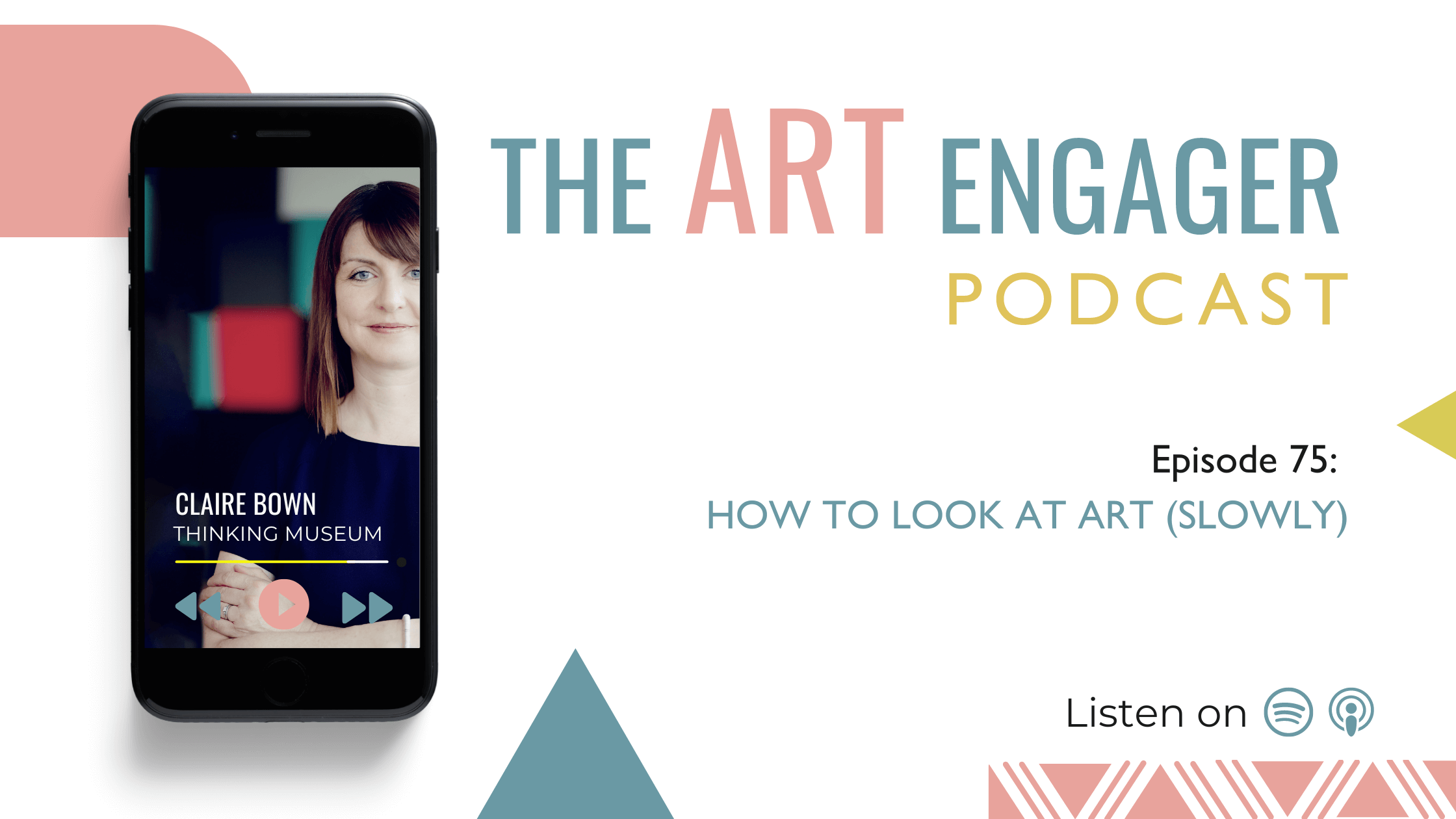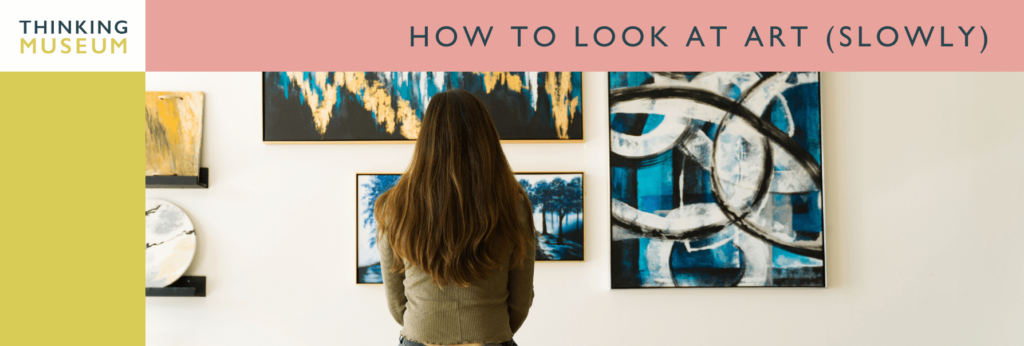We’ve reached another milestone and in honour of 75 episodes, I’m releasing a new resource today which shares 31 different ways that you can look at art or objects in museums.
In this post I’m going to talk you through some of these different ways of looking slowly. I’ll share why it’s important to slow down and look carefully before explaining the 4 sections of the guide: Static Looking, Movement, Observation by Drawing, Observation by Writing and Viewfinders.
How to Look at Art (Slowly) is a resource that can be used by anyone. Whether you’re going to a museum alone and would like some strategies for looking, or if you’re visiting with a friend and are on the lookout for some new ways to engage with what you’re seeing.
Likewise, if you’re an educator or guide, you can use these activities with your groups. All of the activities are coded as either solo or group activities.
These simple activities offer a framework and tools for looking at art and objects and will help you to slow down and look for longer.
Choose a variety of different ways to look as you move around the museum. You may want to choose activities that appeal to you or you might want to step out of your comfort zone and try something new.
All of the activities will help you to see more.
Download this free guide via the link here and then listen to the episode or read the blog below.
WHY IS LOOKING IMPORTANT?
The most important moment in any art or object discussion in a museum or online is the time you spend looking at it when you first arrive at the artwork.
All too often, I’ve been a participant on a tour or I’ve been observing in the background, and I’ve noticed that either the educator jumps straight in with asking a question or proceeds to start describing the artwork for the group.
It is so important to allow your participants time to look. Making space for looking will pay dividends in the ensuing discussion. Too often we are keen to get on to the main course of the discussion – the interpretation – but you should always lay the groundwork first by attending to observation.
By allowing time to look, you are piquing the curiosity of the group. You are allowing them to notice the details for themselves. Questions will start to form in their head and they will be eager to find out more.
Giving space for looking offers the group time to get to know what they are looking at and to begin to process it.
Give your participants the opportunity to take some time carefully observing and they may notice more than meets the eye. It encourages them to push beyond any hasty interpretations they might have – such as ‘I don’t like it’ or ‘I don’t get it’ and more.
Furthermore, people need time to look slowly. We are so used to scanning and scrolling, that we forget what it’s like to take time and really look at something.
WHO IS THIS FOR?
How to Look at Art (Slowly) is a resource that can be used by anyone.
Whether you’re going to a museum alone and would like some strategies for looking, or if you’re visiting with a friend and are on the lookout for some new ways to engage with what you’re seeing.
Likewise, if you’re an educator or guide, you can use these activities with your groups.
ACTIVITIES FOR GROUPS AND SOLOISTS
All of the activities are coded as either solo or group activities. And most of these activities can be done by both soloists and groups.
These activities offer a framework and tools for looking. Use any of the activities in this new resource and you will be sharing tools with your participants that they can use on a future visit to a museum.
How to Look at Art Slowly is divided up into 5 sections – static looking, movement, observation through drawing, through writing and looking with a viewfinder.
Choose a variety of different ways to look at you move around the museum. You may want to choose activities that appeal to you or you might want to step out of your comfort zone and try something new. All of the activities will help you to see more.
1. STATIC LOOKING
In the static looking section, I share activities for looking in silence, in pairs, and in groups.
I share some games you can play to enhance your looking – such as Yes, And…the Observation Game, and observing from memory.
I also talk about guided looking (which is something you would do as an educator or guide to ‘guide’ your participants through the looking process) and mindful looking.
2. MOVEMENT
Quite often, we think of looking as a static process where we just stand in front of an artwork and just look.
However, you don’t need to stand still to look and you can easily incorporate various types of movement into the looking process.
For example, you can vary the distance between you and the artwork or object.
- Look from far away, and then the furthest away you can get and still see it.
- Look at the distance you would if you wanted to take a photo and then close up.
- Or fix your eyes on the artwork as you enter the room and look at it as you are walking towards it.
- Look from seated, standing or lying down.
- Look from above or, my particular favourite, bend down and then look up again – this is wonderful to see new details or how the paint has been applied.
Take steps in a circle around an artwork in a slow dance or move two steps to the left and two steps to the right. - If you’re in a group do some looking from one point and then ask everyone to change positions. Movement works – it helps you to notice new things and to shake up the way you do things too!
- Move your eyes too – play with opening and closing your eyes, turning away and turning back again, one eye open and one shut and squinting at it – this is actually a technique that the so-called professionals use too!
3. OBSERVATION BY DRAWING
I also share 5 ways that you can observe by drawing.
As with all drawing exercises, it’s important to point out that this is an observation exercise and not a drawing one. It’s not to test how good you are at drawing, it’s to see how much you see and observe. Take small sticky notes or notebooks with you to do quick sketches.
4. OBSERVATION BY WRITING
And you can use your notebooks for writing too. I’ve shared 3 quick writing exercises you can do to observe -although lots of the static looking exercises can be done with writing too.
These three thinking routines that I’ve shared encourage you to categorise what you are seeing in words – either through a long list of what you notice or through categories of words such as words, phrases and questions or nouns, verbs and adjectives. These all give you an easy framework through which you can organise your looking.
5. VIEWFINDERS
Last but not least, I’ve shared some ways you can use a viewfinder to look closely. I love viewfinders – so much so that I had some custom ones made for when i used to lead tours.
Viewfinders help you look closer at things (objects, artworks, buildings).
They work particularly well with detailed scenes – where there is so much information to take in at once that it can sometimes feel overwhelming.
The viewfinder helps you to break it down into parts and to focus on just one part, rather than trying to see it all at once. Hold them up close to your eye or at arm’s length.
So I hope you enjoy doing these looking activities in a museum – either as an educator or when you’re visiting for fun on your own or with friends and family.
Do download the free resource and let me know how you get on – I’d love to see photos of your adventures in looking in the museum! You can tag me in on social media!

